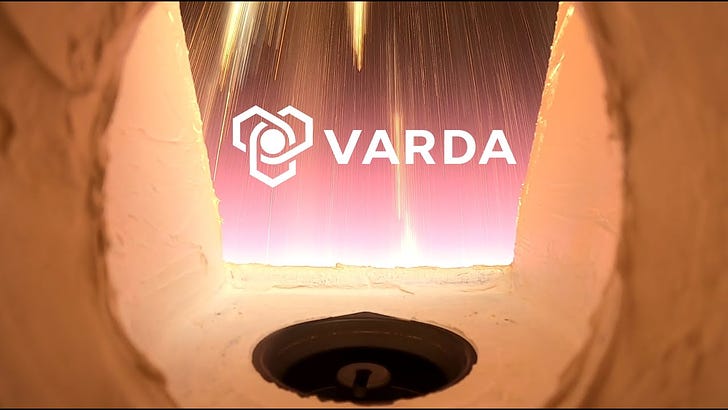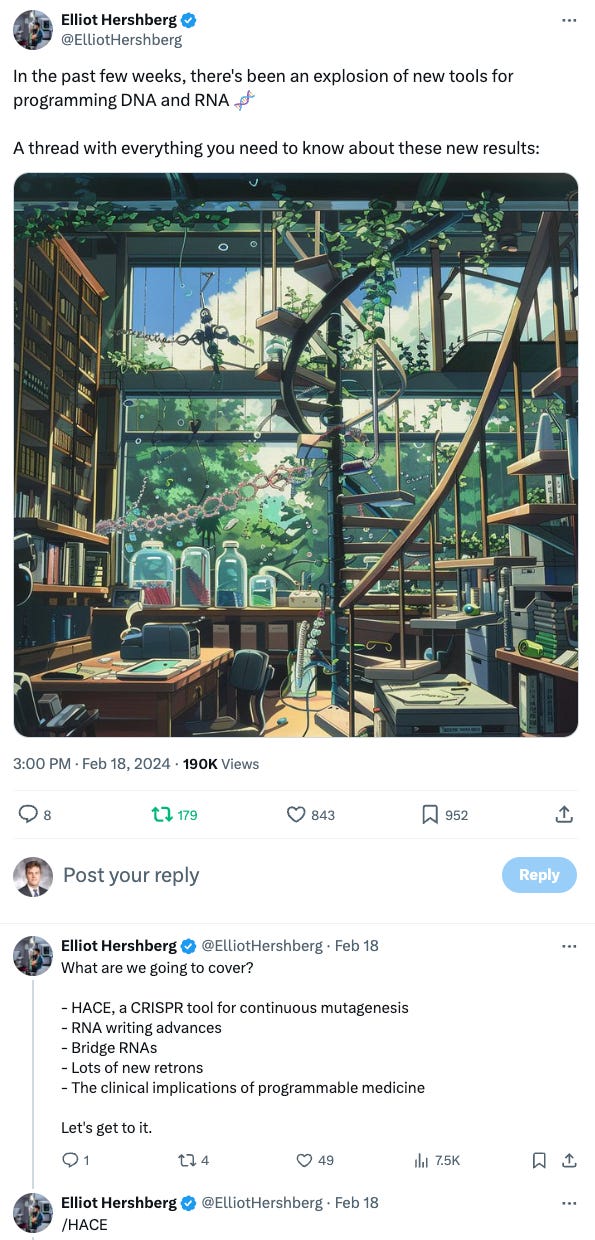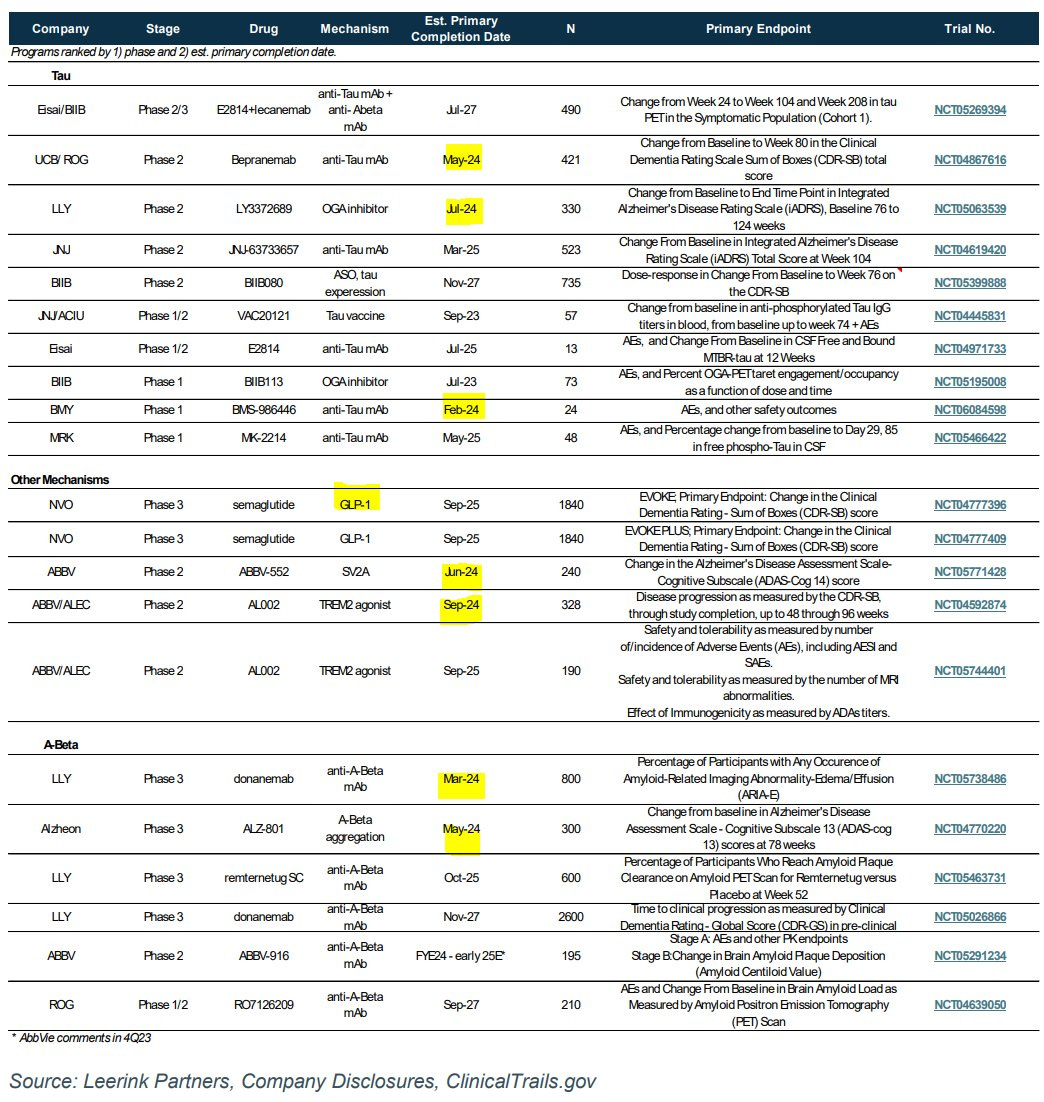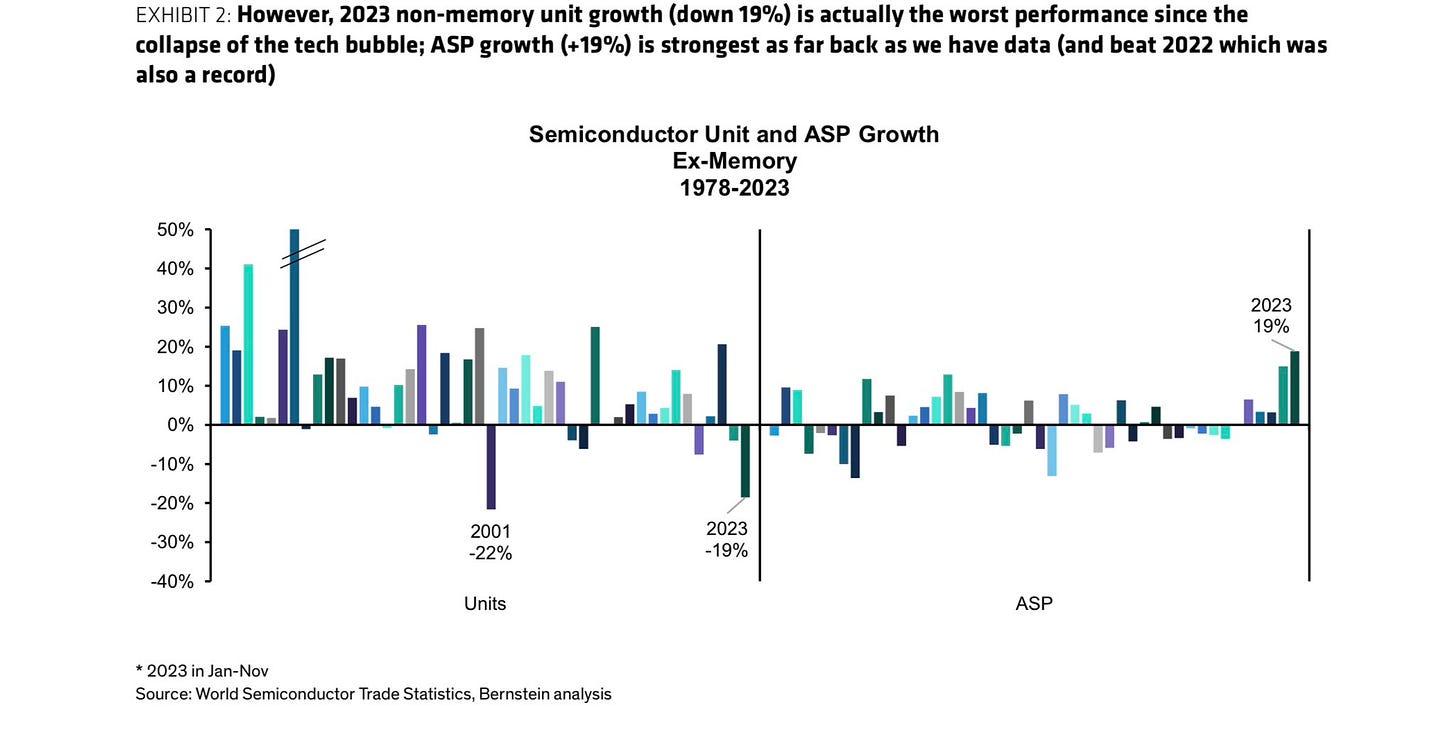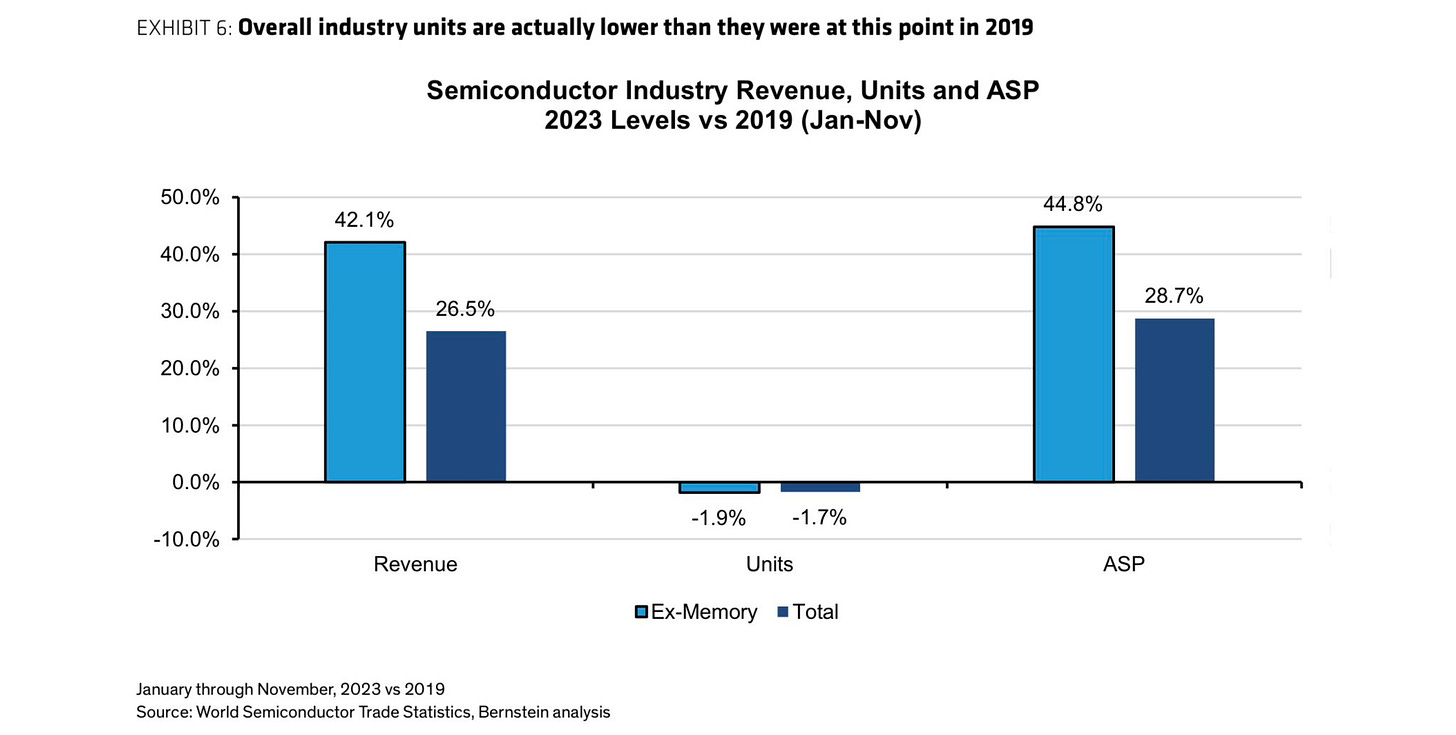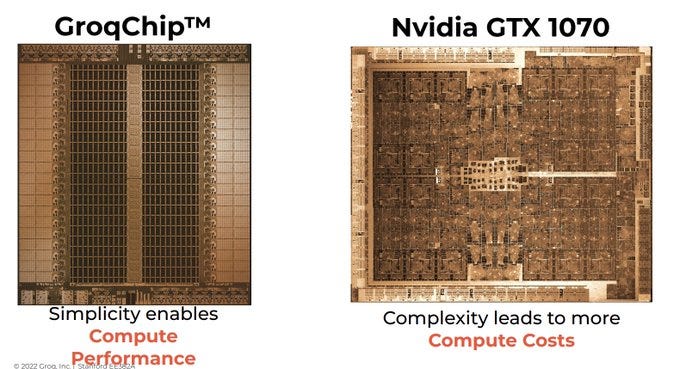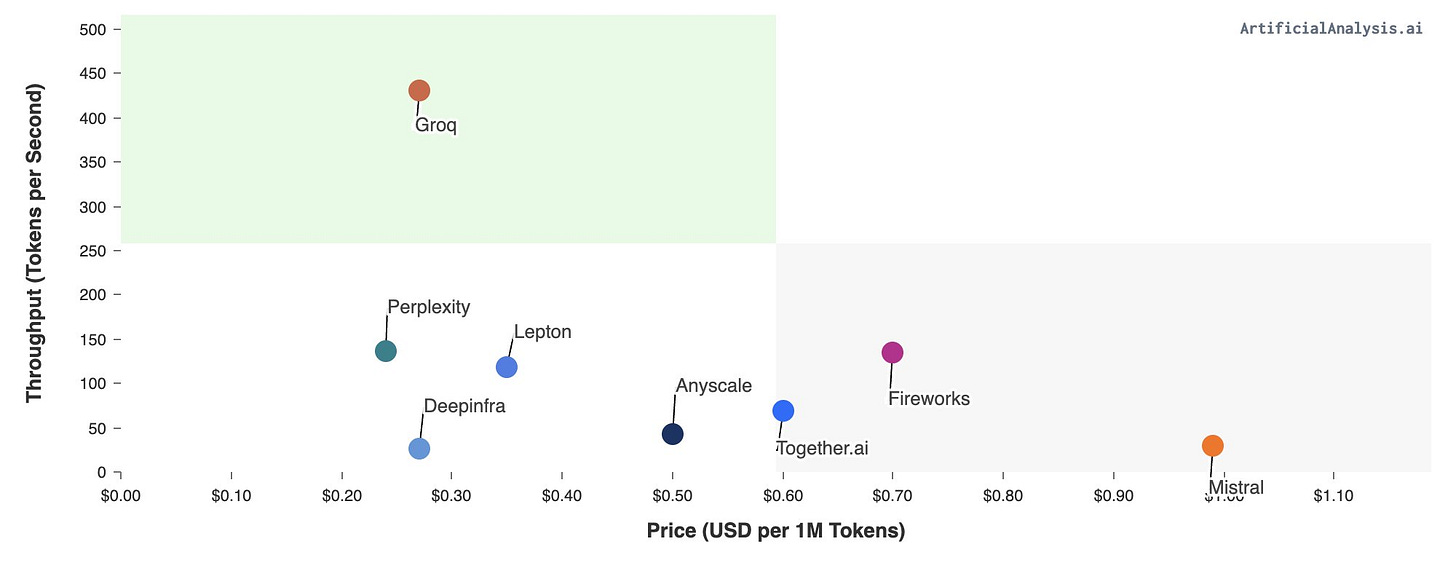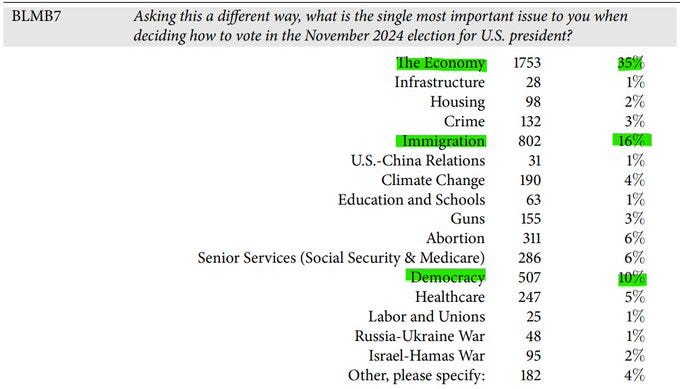A New Era in Quantum Computing, The Booming Space Economy, Editing Gene Expression without Editing DNA, Medical Firsts, Groq, and Secondary Sanctions on Russia
Week 18
Dose of Hope & Innovation in Atoms: science, medicine, & engineering
Intuitive Machine’s spacecraft made a lunar landing, becoming the first privately built spacecraft to do so and the first American vehicle to land on the moon in more than 50 years. Meanwhile, both SpaceX and Blue Origin are racing China to put humans back on the moon by the end of the decade.
Unedited, raw footage of Varda Space’s capsule reentering Earth’s atmosphere at speeds of over Mach 25 after separating from Rocket Lab’s Photon satelite ‘bus’ to orbit in LEO and before successfully landing back in Utah with its payload of therapeutics manufactured in while in zero g’s:
SpaceX just achieved peak download speed of 17Mb/s from satellite direct to unmodified Samsung Android phone. Will work only in areas where no cell services exists (per Elon)
Hypersonics: $500M invested by VC; $8B by gov since 2019 with $18B in ongoing investments, with that money going to primes. DoD says it’ll have capabilities ready mid-decade. It’s working with 15 startups. “Beijing surprised U.S. military leaders when, in 2021, it launched a hypersonic missile over the South China Sea that traveled at speeds of more than 15,000 mph. Russia is using hypersonic missiles against Ukraine, including a new one Moscow says can travel eight times the speed of sound with a 660-pound warhead.” (WSJ)
RNA editing: “avoids the risk of inducing permanent changes or, worse, cutting DNA in places other than the designated target. The mRNA doesn’t last very long in a cell, so any mistakes will quickly disappear.”
An MIT group enabled RNA edits, deletions, and insertions from 1 to >1K nucleotides with minimal off target effects and applied it to several diseases
It’s expected to be highly useful in cell therapies due to the safety reasons above as well as the fact that researchers have only been able to modify a couple genes at once. A Stanford group strengthened CAR-T cells:
The team used the system to address a shortcoming of CAR-T therapy called T-cell exhaustion. If CAR T cells are activated too many times by a chronic infection or a long-term tumor, they become less effective. To give a jolt to tired T cells, the researchers designed CRISPR systems that target mRNA molecules involved in functions including energy production and sugar metabolism. T cells treated with some MEGA combinations stopped expressing molecular signals of exhaustion and became better at shrinking tumors in mice. Qi, Mackall and their colleagues also created a version of Cas13d that is switched on only when the CAR T cells are treated with the antibiotic trimethoprim. By varying the doses of trimethoprim, the researchers could ‘tune’ mRNA levels up and down, giving the team precise control over when and how molecular pathways were activated, rather than just shutting them down entirely.
Epigenetic editing: just two weeks later, we got a totally different approach to non-permanent gene expression manipulation. A group designed a zinc-finger protein (a less easily programmed predecessor to CRISPR) to bind to the PCSK9 gene involved in high cholesterol. They then fused three proteins involved in attaching methyl groups to DNA, our body’s way of promoting or silencing gene expression without editing the underlying DNA sequence. Its effects lasted the 11 months of the mouse study. Apparently, 10 companies are working on developing such therapeutics.
BYD launches $15K attractive looking EV with 200 mile range
House approves bipartisan bill aimed at bolstering nuclear energy:
“The Atomic Energy Advancement Act restores American leadership in nuclear energy and technology which is critical to our economic and national security. I’m proud to lead the most significant update to nuclear energy policy in the United States in over a generation,” Duncan said in a written statement on its passage.
On Wednesday evening, the House approved a bipartisan bill aimed at bolstering the United States’ position in nuclear energy. The Atomic Energy Advancement Act is the U.S.’s first major nuclear energy policy update in over a generation. Like any major bill, there’s a ton going on in it, but at it’s core it accomplishes a few things:
Efficient and Predictable Licensing: Less red tape. Faster timelines. Streamlined reviews. More building. Love to see it.
Advanced Nuclear Technologies: Accepting and supporting new advanced designed in nuclear that are safer and more efficient. In addition, the bill aims to modernize the NRC, particularly in the context of advanced nuclear technologies.
The first-ever RNA editing trial in US gets clearance, pitting Ascidian's ‘exon editing’ technology against Stargardt disease, an inherited form of vision loss. In December, Wave began an RNA 'base editing' trial in the UK. (Endpts)
Self-replicating RNA vaccines are one of the main areas of advancement in mRNA tech, as they potentially require a tiny fraction of the dosage and may consequently reduce adverse effects. Whereas mRNA vaccines encode a protein of interest, replicons have been engineered as a molecular chassis encoding the gene of interest (GOI; transgene) and all essential elements allowing self-amplification of the replicon RNA. The rapid amplification of replicon RNA in target cells increases the expression of the protein of interest (e.g., a viral (glyco)protein) (Figure 1) and induces a protective immune response at a markedly lower initial RNA dose than conventional mRNA vaccines (link). Moreover, since mRNA vaccines encode solely the GOI, they are unable to replicate in, or spread to, neighboring cells. Here’s an update on the field:
Replicate’s vaccines encode instructions for making viral proteins along with molecular photocopy machines that churn out more protein blueprints, mimicking a natural viral infection. The startup hopes its self-replicating RNA approach will lead to stronger and more durable immune responses with lower doses and fewer side effects.
The preliminary results, announced Wednesday via press release, indicate that one or two injections of the shot spurred potentially protective immune responses with doses as low as one-tenth of a microgram — between 300 and 1,000 times lower than what’s used in the Moderna and Pfizer-BioNTech primary vaccines and boosters for Covid-19. Replicate said there were no severe adverse events.
Other companies are developing similar vaccine technologies, including Arcturus Therapeutics, which won approval from Japanese regulators in November for a Covid vaccine, and Gritstone bio, which is also developing a next-gen Covid shot as part of the US government’s follow-up to Operation Warp Speed. (Endpts)
Some upcoming Alzheimer’s focused trials readouts:
The world’s first-ever cell therapy for solid tumors:
An experimental approach to treating cancer more than 40 years in the making finally has a long-sought and repeatedly delayed green light from the FDA.
On Friday, Iovance Biotherapeutics won accelerated approval for Amtagvi, a cell therapy for patients with advanced melanoma. It’s the first modern cell therapy for a solid tumor, rather than blood cancer, and the first approved treatment based on tumor-infiltrating lymphocytes, or TILs.
TIL therapies, pioneered by National Cancer Institute scientist Steve Rosenberg in the 1980s, are based on the observation that immune cells can penetrate and attack tumors, but often get stuck or lose steam before finishing the job due to cancer’s relentless defenses. Iovance dissects those cells from a patient’s tumor, nurtures them in its labs and reinfuses the rejuvenated cells into the patient where they hopefully target the tumor.
While the approach sounds simple, turning the idea into a bona fide medicine has been tricky. Unlike commercial CAR-T cell therapies for cancer, in which a patient’s immune cells are genetically engineered to target a single protein on blood cells, TIL therapies target a different array of cancer antigens in each patient.
Convincing the FDA that the bespoke product would be consistent across patients created an enormous headache for Iovance. After several years of back-and-forth with the agency on how best to assess the treatment’s potency, Iovance hopes to leave those troubles behind and hit the ground running with the commercialization of the treatment.
Amtagvi is approved as a second- or third-line treatment option for patients who still have melanoma despite treatment with the commonly used checkpoint inhibitor immunotherapies. Patients also have to get chemo before receiving Amtagvi in order to clear space for the incoming cells.
Amtagvi shrank tumors in about one-third of 150 patients, with an objective response rate of 31.4%, in a Phase II clinical study. Half of those responses lasted for at least a year, and the mediation duration of the response was not yet reached after 21.5 months.
As a prerequisite of its accelerated approval, Iovance is currently conducting a large Phase III study of 670 people with melanoma to confirm the treatment’s benefit. That study, which will test Amtagvi alone or with Merck’s checkpoint inhibitor Keytruda as a frontline therapy for melanoma, is expected to wrap up between 2028 and 2030.
Iovance is also testing Amtagvi in cervical cancer and is testing a similar TIL therapy in head and neck cancer and lung cancer. The company also has earlier-stage programs to supercharge the TILs and hopefully boost response rates to the therapy with gene editing.
The Land of Bits: software, silicon, algorithms, computation, & robotics
India to build its first ever semiconductor fab ($11B in collab with Taiwanese foundry PSMC). Meanwhile, Google to start building Pixel phones in India.
TSMC’s 1nm fab in Taiwan is rumored to cost $32B
“At the start of January, ASML, the producer of extreme ultraviolet lithography machines, announced that it was canceling shipments to China. While new export restrictions were due to kick in weeks later, the Biden Administration upped the pressure behind the scenes. Based on similar moves with chip exports (where NVIDIA shipments would be blocked ahead of deadlines), this appears to be part of a wider strategy to disrupt stockpiling.” (Guide to AI)
Adept AI unveiled Fuyu-Heavy, the third-most capable multimodal model - behind only GPT4-V and Gemini Ultra, which are 10-20x larger
“Pushing the frontiers of (actual) openness, the Allen Institute for AI unveiled their first Open Language Model (OLMo), released at 7B and 1B, along with its full training data, model weights, training code, metrics, inference code, evaluation and fine-tuning code. Their evaluation suggests it is competitive with Llama 2 across a range of tasks - with different strengths and weaknesses.”
FTC sends inquiry to big tech co’s about partnerships with OpenAI, Anthropic, etc.
Databricks found that over 60% of enterprise customers' LLM applications used retrieval and 30% used complex multi-step chains. (link)
SARA-RT, or Self-Adaptive Robust Attention for Robotics Transformers, is designed to make Transformer models more efficient, which is critical for faster decision-making. It employs a novel method for fine-tuning the model, which the researchers "up-training", to convert "quadratic complexity to mere linear complexity", thereby reducing the computational effort and increasing the speed of the model.
RT-Trajectory is a method that enhances robotic learning through video input. It uses coarse trajectory sketches for policy conditioning, which are used as task specification for an RT-1 policy backbone. For each episode in the dataset of demonstrations, a 2D trajectory of robot end-effector center points is extracted. This method is designed to improve robot movement accuracy in new situations and to extract knowledge from existing datasets.
AI-based productivity gains from MS:
How much has pricing contributed to semiconductor industry growth in recent years? Bernstein Research finds it’s “more than all of it”:
APACE reduced the time required for AlphaFold2 predictions from days to minutes. The process faced limitations in real-time protein structure prediction due to the need for CPU-based tasks like multiple sequence alignment and template search, while GPUs were used for structure prediction. This makes it less suitable for time-sensitive applications or hardware with limited computational power. To solve this problem, the APACE framework was designed from the ground up to run optimally and at scale in modern HPC platforms.
Physics modeling to provide unique guidelines and best practices to the industry for efficient transition of high-speed, unsteady flow from RDC exit into a turbine rotor for reliable work extraction. This will enable the integration of advanced hydrogen-based pressure gain combustion technology into stationary gas turbine plants for decarbonized power generation.
Huerta spoke about how the team combined generative AI, high-throughput screening methods, and large-scale molecular dynamics simulations to model novel, stable and high-capacity metal-organic frameworks for carbon capture within seconds.
A New Era in Quantum Computing
An excellent podcast on the December paper I previously mentioned goes into detail with its author. He agues that with the monumental advancements of his group as well as others, we’re transitioning from the NISQ era defined by the lack of fault tolerant qubits to the logical qubit era. May prove to be a meaningful milestone in the 21st Century. Here are some highlights:
Yeah, I would say by now I'm convinced that the risks are on the algorithm side, not on the hardware side. You know, we have Shor's algorithm. And that one requires thousands of logical qubits and 10 to minus 12 errors. I think the next two years will show whether there's a path towards that. But it would be really sad if we all had a Shor's algorithm.
Q: I mean, an implementation of many physical qubits, rendering highly accurate logical qubits. It feels like it's a breakthrough with commercial relevance. Maybe not in the short term, but still, it's pointing the way towards an outcome that could be real in some amount of time. What's your perspective on that point?
A: I would agree with you. I mean, I myself, you know, even five years ago would have been a skeptic. And I remember, you know, that seven or eight years ago, you know, I was reviewing theory papers, you know, and I was thinking, you know, we will never have 100. What are you talking about? You know, there are theorists and they were proposing protocols and I was just thinking, you know, whatever, you know, we'll never have that. But I think there's a lot of room for optimism.
On the qubits number, sheer number, you know, this system very straightforwardly scale up to say 100,000 qubits, maybe a million qubits, non-physically. So that's just no, because the atoms are really non-interacting in the ground state and therefore you can add as many atoms as you want without disturbing the ones that you have. You know, so they scale very well in qubit number.
The Nature Paper is that system architecture, it's funny because it, I mean, it's describing how you're organizing the optical space of your trap, but it looks very much like a chip architecture. You've got sort of ancillary cubits that are in reserve over in a reservoir, and you're moving them in and out of the entangling zone, and then There's a storage zone. It starts to look like a real, like a real computer system, but in free space, it's really quite striking. Yeah. Like L1, L2 memory and so forth. Yeah, yeah, right.
Yes, it is amazing. It's also kind of interesting. You think about that, you know, we, for each computation, we assemble the memory and microchip, do the computation and throw it away and build a new chip on the next round. Almost a parallel to the von Neumann architecture, almost exactly.
I'll go even step back and say, what do you need for quantum computing? You need qubits and they need to be identical. That's one key requirement. And then you have to be able to switch on and off interactions between these qubits. Qubits have two states that depend on the state of the qubit. And so you can take a few different routes. In superconducting qubits, you can engineer things very well. It's kind of obvious maybe that you can turn on and off interactions with microwave pulses. What is hard for superconducting qubits is to make them very identical because they're always fabricated, they're artificial, so you have to have a very high degree of control in the fabrication to make them as identical as possible. If you come from the other side using atoms or ions, you get the identical, the identity for free, the identicallness for free because all atoms by definition are exactly the same. You know, they are just perfect qubits.
What is hard in the atoms is to do the switchable interactions, especially over distances where you can control. So if you put many atoms into Bose-Einstein condensate, they collide with each other. There are some interactions, but these interactions are very hard to control, and it's also hard to isolate identical qubits. And so what happened first in the ion trapping community was this idea to use Coulomb interactions. So these are long-range interactions so that you could turn on and off interactions in a particular wave of laser beams between separated ions. Ions are relatively easy to trap because they have an electrical charge. Electric forces are very strong. And so that's why ion trap quantum computing was the first one to succeed with gates because they had already, you know, due to the work of Dave Wineland and before Daymelt and so on, had these controlled atoms and interactions over distance. A distance here means micrometers, you know, a few micrometers, 10 micrometers. And for atoms, that's really an unsolved problem because atoms in the ground state only interact when you put them on top of each other, when they collide with each other. But if you put them a few micrometers apart where you can optically control them, you cannot, in general, there's almost no way to do interactions. And the one way to do it is to put atoms in very highly excited states. So everybody maybe knows the hydrogen atoms and remembers this in 1S orbital and the 2S orbital, 3S orbital. but there's also 100S orbital. And this 100S orbital is such that the electron is at a micron distance from the nucleus. So you could take a whole COVID virus and put it inside the atom and the electron would be going around. So it's a gigantic atom and what that means is that these atoms react to tiny electric fields because the electron is so far away from the nucleus it can be polarized very easily. And what that also means if you take two such Rydberg atoms, two atoms in this 100S state, and put them at a microscopic, well not macroscopic, but you know, kind of micrometer distances from one another, they start to interact very strong. And that's very important, so a typical scale is maybe hundreds of megahertz to gigahertz, and that's important because this energy scale also sets the inverse of that, given by Planck's constant sets the time, at which you can, the speed of gates. And these Rydberg atoms are very nice because they have large interaction strings at hundreds of megahertz energy spacings or interaction strengths, this also sets a corresponding speed to be close to that, some defect or below that.
Kevin Rowney (12:28)
And I gather a range long enough that you can manipulate them to close together for interaction via laser.Vladan Vuletic (12:34)
Exactly. So there were really two key breakthroughs. One is, you know, to control these Rydberg states. And then the other breakthrough was this ability to make deterministically arrays of many single atoms. It's interesting. So it was 20 years ago in 2003 when a group in Paris, Philippe Granger, for the first time trapped a single atom and saw it. So they used kind of something that was known from Bose-Einstein condensates. They used laser traps and laser cooling.laser beam as focused as tightly as possible. So usually before that we used kind of bigger traps, big means maybe 100 micrometers or so where you can fit in many atoms to do, say both Einstein condensates. And what they tried is let's make a focus that is, you know, limited to the, by the fraction to the one micrometer scale. And they saw that they could trap a single atom half the time. And so that was kind of a break from, but maybe it wasn't really appreciate it as much as it should have been because it was still, if you have 50% of the time an atom inside and 50% not, you can't put 100 traps together and expect to have 100 atoms. Very unlikely. It was very impressive that you could image it, you could use fluorescence from the single atom. Something that people had done in the ion community for a long time, since the 1990s, but this was now a breakthrough in the nuclear atom world for single atoms. And now the idea came in 2016, we did a paper with Misha, where we for the first time basically used the feedback mechanism to load many atoms, many traps with 50% probability.
Q: So let's see, I mean, for the future of your lab and the team that worked on this paper, are you guys doubling down on this and moving forward with larger scale or is there some new frontier dimension of the research that you're not pursuing for your next achievement?
A: Yes, definitely to make these things bigger, better, higher quantum gates. So we are trying to push to qubit gate fidelity was 99.5% for this work and in previous work. This was important because it was above the or below the threshold for the surface code, which is 1%, right? So this is basically the break even. So we are beyond the break even point. We're actually making the system larger, improve things. We. made it across the threshold, but the small, you know, the better we make the physical two-qubit error, the better it scales. It scales exponentially ultimately, right? So we are really one frontiers to push for 99.9 two-qubit gate fidelity, which would put us a factor of 10 below the surface code threshold and would allow him to still logical errors to be smaller. That's one frontier.
The other frontier is to go to larger field of view systems. What we call, you know, basically we are focusing in laser beams, so we have microscopes and there's an active area that you can use, which we call field of view. So we would like, that's a few hundred micrometers in the first generation. We are building a new generation experiment that will be one, two millimeters square field of view where you can fit all these atoms. So we're no longer limited by the area, we'll be just limited by laser power, for instance, of how many traps we can. And then we are working on geometry.
One very important next goal is to show a FAS called mid-circuit readouts, so really to close the feedback loop on error correction. What we haven't done in this paper is actually close the loop. We have shown that you can detect errors, but we haven't actually used this information to feed back in real time to make the calculation depth much deeper. So that's one of the next goals to put into a full feedback loop, as far as I know.
Groq
The latest competitor to NVIDIA to generate buzz, Groq focuses on making AI chips that offer super fast token generation. Their video demonstrations at speeds of 480 tokens / sec are 3-4x standards. Speed in software, especially consumer-facing, has always been crucial. Improving speed by 100 milliseconds increases user engagement by 8% on a website on desktop and by 34% on mobile. Some applications / user experiences aren’t even feasible with slow speeds. This is all the more important in interactive AI systems like chatbots, where the illusion of speaking to a fellow intelligence is broken in a far more fundamental and emotional way than loading a regular website. Groq’s speed allows for natural spoken conversation with an LLM, as seen in this must watch video. Below is detail on the company and its chip design and here’s a podcast on the founding story and thesis.
The CEO describes his approach the following way:
Most chips don't have enough memory inside of them, sort of like if you were building cars and you use a giant factory. Let’s say you need about a million square ft of assembly line space. Well, if you don't have a building that's large enough to fit that then, you need to set up part of the assembly line tear it down over and over again. That's slow and it takes a lot of time and that's what happens with the GPU you have to read from that memory so thousands of times for every word that comes out it's as if you're setting up the assembly line over and over
An estimate of CAPEX & OPEX costs for Groq by an AI compute provider suggests it’s not price competitive:
Groq CEO responded with this estimate:
We’ll see. So far, no alternative company can touch NVIDIA with a 10ft pole:
C.R.E.A.M: macro, markets, commodities, and geopolitics
Secondary Sanctions on Russia
After Russia’s invasion of Ukraine, the US government asked domestic entities to stop dealing with Russia. These restrictions, however, didn’t extend globally so many such transactions were displaced to third-parties like Turkey. Recently, the Biden admin moved to place “secondary sanctions”:
Turkish banks halted transactions with Russian banks in January after the first round of secondary sanctions were announced on Dec 22. They’re slowly reintroducing payments for green listed products.
With that said, the secondary sanctions that apply are quite narrowly focused on industries also targeted under the export control regime. Here’s some color:
My guess is that the Biden admin learned export controls alone weren't preventing Russia from acquiring critical military components, in part, because banks in non-Western countries were willing to clear Russian payments for these goods. If those banks don't operate in countries that are party to the financial sanctions regime, there was no consequence for doing this. The secondary sanctions change this. Now, those banks will be cut off from doing business with US banks (e.g. clearing dollars thru CHIPS) if they continue to clear Russian payments within these narrow industries covered under the secondary sanctions.
So, this adds a financial layer to the existing export controls that already make it difficult for Russia to acquire those critical components. This should make it much harder.
But it is important to note that this is not a broad secondary sanctions regime. Non-US banks can still clear payments for Russian clients outside of these specific industries. This includes key major Russian export categories, like metals and energy.So, these secondary sanctions do not really target Russian export earnings. I would not describe them as "comprehensive" as they are quite narrowly tailored. The fact remains that the Biden admin continues to refrain from using the most significant type of financial sanctions against Russia. Comprehensive secondary sanctions on major Russian banks and key export sectors would produce considerable spillovers to the global economy.
Q: Do you think the risks are greater than with Iran (or viewed as greater) because of the relative size of Russia vs. Iran, the relative economic integration of Russia vs. Iran, or the relative political integration of Russia vs. Iran (e.g. Iran not friendly w other Gulf states)?
A: I'd say all of the above matter, + Trum admin cared less abt political blowback (e.g. frayed relationship with Europe). Also, post-10/7, Biden is juggling two major crises at once & the countries you need to help stabilize the crisis in the Middle East (e.g. Gulf states are the states you might alienate if you adopted maximalist sanctions on Russia.
To get an idea for what might happen to Russia's military-industrial goods trade, take a look at how Iran's oil exports were halved after Obama imposed secondary sanctions on Iran in 2012, leapt when they were lifted in 2016, and crumbled again when Trump reimposed them in 2018.
Evasion efforts will begin very quickly. When secondary sanctions were first placed on Iran in 2012, Turkish bank Halkbank introduced a forged document scheme in an effort to disguise trade in sanctioned crude oil shipments as legitimate food transactions. The U.S. will have to step up its enforcement efforts to plug these holes. Without proper enforcement, the effect of the secondary sanctions will remain muted.
Here’s more thoughts on the topic.

